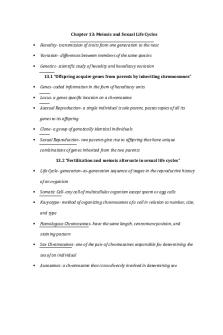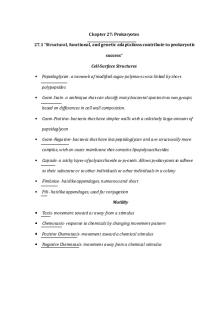Campbell Biology 11th edition chapter 44 summary PDF

| Title | Campbell Biology 11th edition chapter 44 summary |
|---|---|
| Author | Laura Ramos |
| Course | Biology Science Maj II (lec + Lab) HNS |
| Institution | Tarrant County College |
| Pages | 3 |
| File Size | 63.8 KB |
| File Type | |
| Total Downloads | 10 |
| Total Views | 152 |
Summary
This is a chapter summary ...
Description
Osmoregulation and Excretion
One of the fundamental biological processes in living beings and, above all, for those who live in aquatic ecosystems is osmoregulation, also known as osmotic balance. All the metabolic reactions necessary for life take place in an aqueous or liquid medium. For the proper functioning of these reactions, it is necessary that the concentrations of water and solutes (all those organic compounds of low molecular weight that help maintain osmotic balance) oscillate within relatively narrow margins, in a process called osmoregulation.
We can define osmoregulation as the method that maintains the homeostasis of the body, which is nothing other than the ability of living organisms to maintain their internal condition stable based on the changes that can occur abroad through the exchange of matter and energy with it. All this depends on a crucial way of the controlled displacement of the solutes existing in the internal liquids and those found in the environment. This leads us to the regulation in the movement of water plays a fundamental role. Said regulation of the movement of water is carried out by osmosis, which is a corporal phenomenon constructed on the movement of a solution fluid that crosses a semipermeable membrane. This singularity rises thanks to a very simple dispersion that does not need energy outflow and that becomes vital for the right cellular metabolism of living beings. In short, and by way of general summary, osmoregulation helps us to make the concentrations of solutes in the interior of organisms (example: cells) and the environment that surrounds them, tends to balance through movement and flow through a semipermeable membrane. Such a circumstance allows us to regulate the osmotic pressure (pressure that is exerted on in order to stop a certain flow of solvent that penetrates a membrane).
Osmosis Means Diffusion of the solvent, understood as diffusion to the spontaneous passage of molecules from higher to lower concentration, and as solvent (Water) to the compound in which the solute dissolves (IONS)
Then we can define OSMOSIS as: The spontaneous passage of solvent (WATER) from a place where there is greater concentration of it to another where there is less concentration.
The spontaneous passage of the molecules occurs from an extra cellular site to an intracellular one or vice versa and for this the molecules pass through a semipermeable membrane = the cellular membrane the exact amount to stop the diffusion of molecules (OSMOSIS) is called: OSMOTIC PRESSURE and is mediated by the same interaction of these molecules.
OSMOLALITY Concentration of a solution based on the weight of the number of solutes in it called OSMOL instead of grams.
In the cellular metabolism a series of substances is formed that must be expelled from the organism, as some of them are very toxic, such as nitrogen waste. Others are not, but they can be a problem for the animal, depending on its habitat, such as mineral salts for aquatic animals. Many metabolic wastes are expelled through the skin, even in highly evolved animals. However, specialized structures appear in the filtration of the internal environment that, in addition to expelling toxic substances, control the parameters of water, mineral salts and nutrients inside the animal. The expulsion of nitrogen can be done through different molecular forms, such as ammonia, urea or uric acid. • Expulsion in the form of ammonia implies the possibility of constantly capturing a large amount of water, since the ammonia must be immediately expelled and dissolved in water. If this were not so, the animal would die. Therefore, animals that expel ammonia as a product of nitrogen waste are animals that live in water, such as osteotic fish. These types of animals are called ammoniotics. • Sharks and rays, adult amphibians, turtles and mammals expel urea as a nitrogen waste product. These animals are called ureothelics. Urea is formed when amine radicals bind to carbon. This substance, despite being toxic, can be stored inside the animal as long as it is dissolved in abundant water. • Animals that need to restrict the loss of water, such as insects or reptiles, or that cannot accumulate large amounts of water due to their way of life, such as birds, expel uric acid as a nitrogenous waste substance. These animals are called uricotelic. This substance is expelled in solid form and does not cause loss of water. Excretory function is also a controlling structure of the inner environment, that is, it regulates the volume of water and salts that are in the body at all times and ejects the surplus of them this way it aloud chemical configuration and volume are kept persistent of the inner environment (homeostasis). This is how living organisms ensure their survival against environmental variations. It can be said that excretion carried out by excretory devices involves several processes: • Excretion of waste products from cellular metabolism. • Osmoregulation or regulation of osmotic pressure. • Ion regulation or regulation of ions in the internal environment. In all multicellular animals, excretion must be carried out by means of specialized excretory devices that take waste substances from the internal environment and transport them outside the animal. In all of them three types of processes have to be carried out: 1. Filtration: What is the passage of body fluids, by diffusion, into the excretory tubes. It is an initial urine, which carries in addition to waste substances, many other molecules necessary for the organism, which will return to the internal environment of the organisms thanks to the process of:
2. the reabsorption: which is carried out along the excretory tubes, whose cells will extract large quantities of water and substances useful for the organism from this initial urine, returning them to body fluids. 3. The secretion operates in the opposite direction and transfers materials from body fluids to excretory tubes, primarily ions, such as K +. The liquid obtained is the final urine, which will be expelled outside....
Similar Free PDFs

Ch26 - Summary Campbell Biology
- 6 Pages
Popular Institutions
- Tinajero National High School - Annex
- Politeknik Caltex Riau
- Yokohama City University
- SGT University
- University of Al-Qadisiyah
- Divine Word College of Vigan
- Techniek College Rotterdam
- Universidade de Santiago
- Universiti Teknologi MARA Cawangan Johor Kampus Pasir Gudang
- Poltekkes Kemenkes Yogyakarta
- Baguio City National High School
- Colegio san marcos
- preparatoria uno
- Centro de Bachillerato Tecnológico Industrial y de Servicios No. 107
- Dalian Maritime University
- Quang Trung Secondary School
- Colegio Tecnológico en Informática
- Corporación Regional de Educación Superior
- Grupo CEDVA
- Dar Al Uloom University
- Centro de Estudios Preuniversitarios de la Universidad Nacional de Ingeniería
- 上智大学
- Aakash International School, Nuna Majara
- San Felipe Neri Catholic School
- Kang Chiao International School - New Taipei City
- Misamis Occidental National High School
- Institución Educativa Escuela Normal Juan Ladrilleros
- Kolehiyo ng Pantukan
- Batanes State College
- Instituto Continental
- Sekolah Menengah Kejuruan Kesehatan Kaltara (Tarakan)
- Colegio de La Inmaculada Concepcion - Cebu














